TyA (Message Wall | contribs) m (→Honors) |
m (Removed protection from "Crayon Shin-chan: Fierceness That Invites Storm! The Adult Empire Strikes Back") |
| (One intermediate revision by the same user not shown) | |
(No difference)
| |
Revision as of 16:14, 31 October 2020
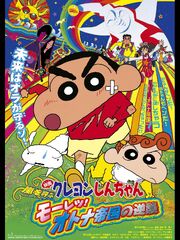
Crayon Shin-chan: Fierceness That Invites Storm! The Adult Empire Strikes Back
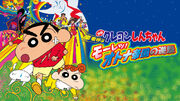
Crayon Shin-chan: Fierceness That Invites Storm! The Adult Empire Strikes Back (クレヨンしんちゃん 嵐を呼ぶ モーレツ!オトナ帝国の逆襲 Kureyon Shinchan: Arashi o Yobu: Mōretsu! Otona Teikoku no Gyakushū) is a Japanese anime film released in 2001. It is the ninth installment of the Crayon Shin-chan series. The name is a reference to The Empire Strikes Back. It was released as Crayon Shinchan The Movie: Counter Attacking the Adult's Empire with English subtitles on VCD and DVD by PMP Entertainment.
Shin-chan must rescue the adults of Kasukabe when they mysteriously abandon their responsibilities to relive their youth at the new 20th-century expo.
A new 20th century museum has opened in Kasukabe! Looking like a striking replication of the 1970 World Expo, the museum quickly wins over the hearts and minds of the adult population. It becomes clear to Shin-chan that the designers of the museum have ulterior motives as all the adults flock to the museum and lose their memories, returning to the comfort and nostalgia of the 20th century. It’s up to Shin-chan and his friends to unravel this heinous plot and return their parents to the 21st century before the whole world follows them into the past!
Manga
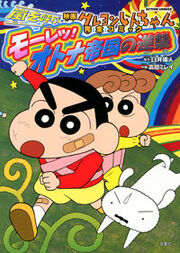
Manga
Japan: July 16, 2010 - 978-4-575-94290-3
Plot
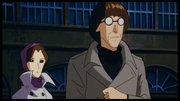

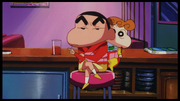
A new 20th century museum has opened in Kasukabe! Looking like a striking replication of the 1970 World Expo, the museum quickly wins over the hearts and minds of the adult population. Even though adults like Hiroshi and Misae are filled with fascination and excitement, children like Shin and Himawari are disinterested and concerned for their parent's nostalgia. As this goes on, Ken and Chako (the owners of the convention) discuss plans to "rid of the smell of the 21st century." This takes into effect during the night as Hiroshi and Misae suddenly sleeps for the night.
The next morning, Shin finds that Hiroshi and Misae have become very crude and irresponsible. After angrily leaving the house for kindergarten, Shin (taking Himawari along with him) finds that every adult is acting childlike; this even extends to the kindergarten he goes to. Suddenly, trucks appear and take every adult to a place where only the 20th century exists. Shin and his friends meet at his house to discuss the events that occurred in their hometown. Not only they found out that children are trying to survive without their parents, the media they are watching and listening to is reverting to the 20th century; this is only made worse when the electricity shuts down. Later, trucks appear and several workers claim that they arrive to pick up the children and reunite them with their parents; however, Shin and his friends realize this is nothing more than a trap, and that they heard they will come back to capture other stray children. After deciding to not stay where they are, Shin, Himawari, his friends, and his dog Shiro take refuge in a department store.
As the hunt for more children beings, Shin and his friends realize that they overslept and must leave immediately. After failing to hide from the henchmen (including several adults that Shin knows), Shin, his friends, and what is left of his family go on the run. Several hi-jinks later, they decide to steal the principal's bus to escape from the adults. Accidentally going to the land of the 20th century, Shin and everyone in the bus decides to find and confront their parents. After crashing the bus inside the building, Shin's friends are captured; however, Shin, Himawari, and Shiro are able to escape. Finding the door where Hiroshi is reliving his childhood, Shin found out that the smell of the 20th century is affecting the adults; as such Shin uses his father's bad feet odor to neutralize the 20th smell that is affecting Hiroshi. Realizing that the hardships of growing older gave him the family he loves, Hiroshi is successfully brought back to reality. After finding Misae, Ken decides to take Shin and his reunited family to the source of the 20th century. He explains that his machine will launch the smell of the 20th century, thanks to the added scent of the people living in the false 20th century. Because of the situation at hand, Hiroshi, Shin, Misae, Himawari, and Shiro must stop the evil plan before it is too late. One by one, Shin's family distracts the henchmen to buy him time. With the future at stake, Shin desperately dashes to the control room.
Though Shin failed to reach the control room before Ken and Chako, the actions of him and his family made those living in the 20th century realize that they want to go back to the future. As a result, the smell of the 20th century is disappearing. Even though they accept defeat, Ken and Chako are unable to accept the future; therefore, they attempt suicide at the top of the building. But as they attempt the act, they are halted by a pigeon protecting its family. With their suicidal actions stopped, Ken and Chako realize that they too must find a place to live. Several children and adults are reunited and sent back to their hometown. Shin and his family return home where the future awaits.
Characters
References to the 20th century
- The name of the antagonists has its origin in a children's series that was aired in Japan during the 80s, "Chako-chan Ken-chan" (ケンちゃんチャコちゃん).
- Throughout the film, the song "Yesterday Once More" by The Carpenters, a popular American duo in the 70s, sounds a lot.
- The title of the film, as already mentioned, is a tribute to the fifth installment of one of the cinematographic sagas that marked the second decade of the century: Star Wars.
- There are references to classic Japanese characters from the end of the century, such as the mangaka Fujio Akatsuka (赤塚 不二夫), the Ultraman series (ウルトラマン), set in the 60s, and the comedian Kazuki Kosakai (小堺一機).
- There are constantly objects typical of this century: gramophones, videocassettes, as well as cars typical of the last century, such as the Toyota 2000GT.
Honors
- Kinema Junpo's Top Anime Films of All Time #4
- The movie was voted as the best Crayon Shin-chan movie on the 20th anniversary of the series, in an award ceremony called "Bakademy Awards" in 2012.
Staff
- Created by Yoshito Usui (Rakudasha)
- Key Animation Supervisors: Katsunori Hara, Noriyuki Tsutsumi, Masuo Mamada
- Character Designers: Yuichiro Sueyoshi, Katsunori Hara
- Music: Toshiyuki Arakawa, Shiro Hamaguchi
- Written and Directed by Keiichi Hara
- Animation Director: Tsutomu Mizushima
- Shinnosuke: Akiko Yajima
- Misae: Miki Narahashi
- Hiroshi: Keiji Fujiwara
- Himawari: Satomi Korogi
- Chako: Ai Kobayashi
- Ken: Masane Tsukayama
- (c)Usui Yoshito / Futabasha\NSHIN-EI Animation TV Asahi ADK 2001
